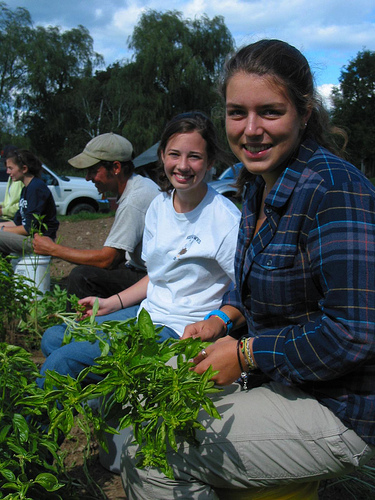 Microloans could encourage young people to become farmers.Photo: Chewonki Semester SchoolUSDA Secretary Tom Vilsack recently called for 100,000 new farmers — a recognition that the U.S. farm population is aging rapidly. To create a revitalized, sustainable, and socially just food system, we need to cultivate a new generation of farmers — and quickly.
Microloans could encourage young people to become farmers.Photo: Chewonki Semester SchoolUSDA Secretary Tom Vilsack recently called for 100,000 new farmers — a recognition that the U.S. farm population is aging rapidly. To create a revitalized, sustainable, and socially just food system, we need to cultivate a new generation of farmers — and quickly.
But starting a business takes cash, and a farm is no exception. For beginning farmers, the ability to come up with enough money for things like rent, tools, fencing, animals, and feed is likely to determine whether they’ll be in business at all.
In an ongoing survey of young farmers conducted by the National Young Farmers’ Coalition, 53 percent of respondents cited lack of capital as the biggest obstacle to starting a farm. A 2008 survey of 706 New York and New England farmers found that 25 percent of farmers were denied financing.
In the last farm bill, a new Individual Development Account program was created to help beginning farmers save money, but it has yet to receive any funding of its own. And assuming that the new penny-pinching House won’t be of any help, it’s probably time to think about alternatives.
The best opportunity may lie in the USDA’s 40-year-old Rural Youth Loan program. With a few changes in the 2012 farm bill, this program could be the microcredit that the next generation needs.
The Rural Youth Loan program was created to provide opportunities for youth living in communities with fewer than 50,000 residents to learn about agriculture and start income producing businesses. And by youth, they really mean it. Loans are given out to kids as young as 10 and as old as 20. A USDA video tells the story of the Hungate boys of Idaho, ages 9, 11, and 12, who were given a $5,000 loan to buy four cows. Drake, the eldest Hungate, reports, “we got really good interest — and we locked it in at 3.2 percent.”
In the 2012 farm bill, a new category of youth loans could be created for young people ages 21-35. The loans could double or triple the lending limit, but remain accessible for the young farmer with limited experience.
Adrian de los Santos, a former Farm Service Agency loan agent and now an outreach coordinator with the Texas Mexico Border Coalition, says that microcredit is “very much needed” for the farmers that he works with in rural Texas. “Fifteen thousand is not a lot,” says Santos, “but it could be enough to get started.” Santos points to farmers like Diana Padilla of Yahweh Farms, who is trying to get a loan to install a drip irrigation system on her diversified vegetable farm. Padilla can get a grant for the irrigation system from the USDA, but still needs cash to pay for the system up front.
The USDA does offer operating loans, but they’re geared for growers looking for bigger loans. “Because the Farm Service Agency requires the same amount of paperwork for a $100,000 loan and a $5,000 loan,” says Santos, “they shy away from making a small loan — unless it’s a youth loan.” Additionally, the managerial requirements for USDA operating loans overlook the entrepreneurial young person. Current rules require that operating loan applicants have a four-year degree in an agricultural field, some combination of vocational training, and on-farm experience, or farm ownership or management experience for an entire production cycle.
Frustrated at the lack of credit opportunities for small and beginning farmers, Santos is now organizing the Tip of Texas Farmers Co-op. “Tip-o-Tex” will offer access to a multi-farm CSA and small loans to its producers like Padilla. The initiative received initial funding through the Rio Grande Valley Empowerment Zone and will operate as a nonprofit organization and for-profit business. The co-op will operate as a typical for-profit business and the nonprofit side will offer producers loans, marketing, and start-up assistance.
Non-governmental organizations, like the one that Santos is forming, have been picking up the slack on existing federal credit programs for some time. Innovative projects like the Carrot Project, California Farm Link’s individual development account program, Northeast Organic Farming Association of Vermont’s revolving loan fund, and the Maine Organic Farmer and Gardeners Association’s organic farmer loan fund demonstrate the need for and the potential of microcredit for small farmers.
But these programs can’t be expected to meet the needs of an entire generation of new farmers alone. Vilsack’s call for 100,000 new farmers requires action at the federal level. The Rural Youth Loan program, designed to provide the nation’s youth their first experience in agriculture, may be that opportunity.



